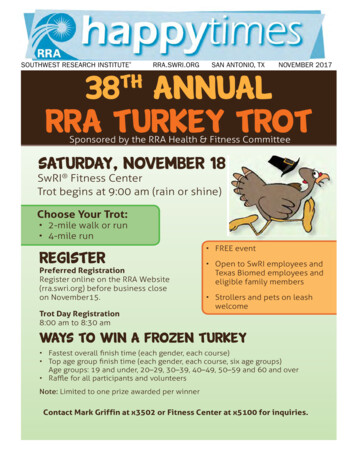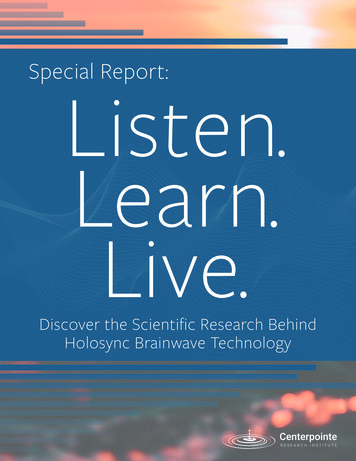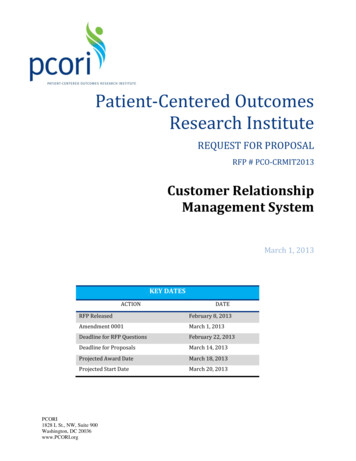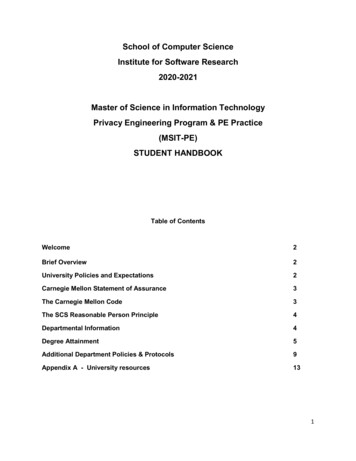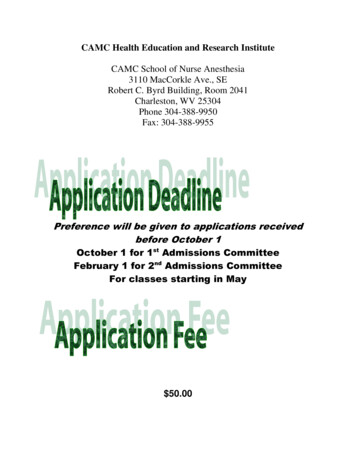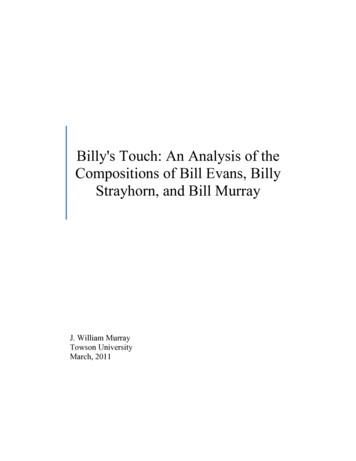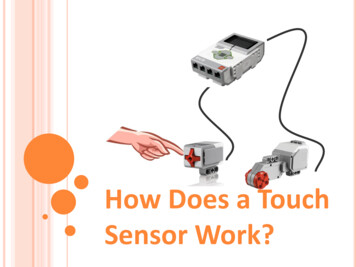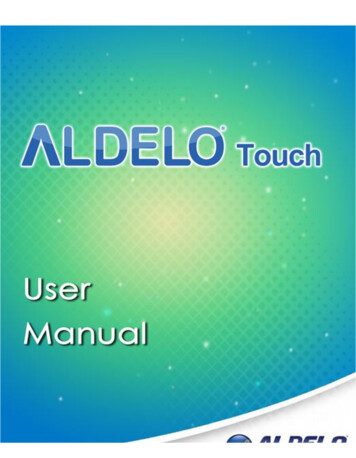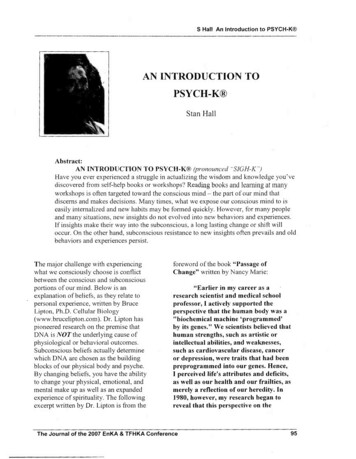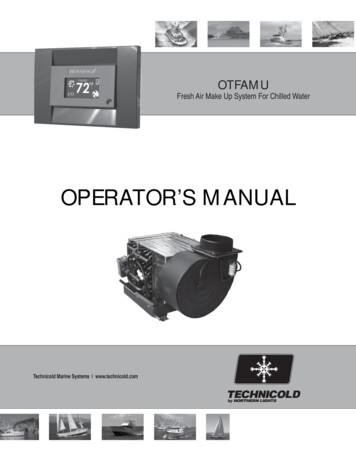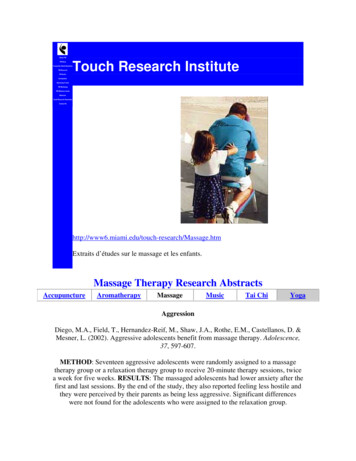
Transcription
Touch Research age.htmExtraits d’études sur le massage et les enfants.Massage Therapy Research AbstractsAccupunctureAromatherapyMassageMusicTai ChiYogaAggressionDiego, M.A., Field, T., Hernandez-Reif, M., Shaw, J.A., Rothe, E.M., Castellanos, D. &Mesner, L. (2002). Aggressive adolescents benefit from massage therapy. Adolescence,37, 597-607.METHOD: Seventeen aggressive adolescents were randomly assigned to a massagetherapy group or a relaxation therapy group to receive 20-minute therapy sessions, twicea week for five weeks. RESULTS: The massaged adolescents had lower anxiety after thefirst and last sessions. By the end of the study, they also reported feeling less hostile andthey were perceived by their parents as being less aggressive. Significant differenceswere not found for the adolescents who were assigned to the relaxation group.
AnorexiaHart, S., Field, T. & Hernandez-Reif, M., Nearing, G., Shaw, S., Schanberg, S., & Kuhn,C. (2001). Anorexia nervosa symptoms are reduced by massage therapy. EatingDisorders, 9, 289-299.METHOD: Women diagnosed with anorexia nervosa were given a massage twice perweek for five weeks or standard treatment. RESULTS: The massaged women reportedlower stress and anxiety levels and showed lower cortisol levels immediately followingthe massage. Over the five-week treatment period, they also reported decreased bodydissatisfaction on the Eating Disorder Inventory and showed increased dopamine andnorepinephrine levels.AnxietyField, T., Morrow, C., Valdeon, C., Larson, S., Kuhn, C. & Schanberg, S. (1992).Massage reduces anxiety in child and adolescent phychiatric patients. Journal of theAmerican Academy of Child and Adolescent Psychiatry, 31, 125-131.METHOD: A 30-minute back massage was given daily for a 5-day period to 52hospitalized depressed and adjustment disorder children and adolescents. RESULTS:Compared with a control group who viewed relaxing videotapes, the massage subjectswere less depressed and anxious and had lower saliva cortisol levels after the massage. Inaddition, nurses rated the subjects as being less anxious and more cooperative on the lastday of the study, and nighttime sleep increased over this period. Finally, urinary cortisoland norepinephrine levels decreased, but only for the depressed subjects.Shulman, K.R. & Jones, G.E. (1996). The effectiveness of massage therapy interventionon reducing anxiety in the work place. Journal of Applied Behavioral Science, 32, 160173.METHOD: An on-site chair massage therapy program was provided to reduce anxietylevels of 18 employees in a downsizing organization. 15 control group Ss participated inbreak therapy. Subjects’ stress levels were measured with the State-Trait AnxietyInventory, which was administered twice during pretest, post test, and delayed post test toachieve stable measures. RESULTS: Significant reductions in anxiety levels were foundfor the massage group.
ArthritisField, T., Hernandez-Reif, M., Seligman, S., Krasnegor, J. & Sunshine, W. (1997).Juvenile rheumatoid arthritis: Benefits from massage therapy. Journal of PediatricPsychology, 22, 607-617.METHOD: Children with mild to moderate juvenile rheumatoid arthritis were massagedby their parents 15 minutes a day for 30 days (and a control group engaged in relaxationtherapy). RESULTS: The children’s anxiety and stress hormone (cortisol) levels wereimmediately decreased by the massage, and over the 30-day period their pain decreasedon self-reports, parent reports, and their physician’s assessment of pain (both theincidence and severity) and pain-limiting activities.AsthmaField, T., Henteleff, T., Hernandez-Reif, M., Martinez, E., Mavunda, K., Kuhn, C. &Schanberg, S. (1998). Children with asthma have improved pulmonary functions aftermassage therapy. Journal of Pediatrics, 132, 854-858.METHOD: Thirty-two children with asthma (16 4- to 8-year-olds and 16 9- to 14-yearolds) were randomly assigned to receive either massage therapy or relaxation therapy.The children’s parents were taught to provide one therapy or the other for 20 minutesbefore bedtime each night for 30 days. RESULTS: The younger children who receivedmassage therapy showed an immediate decrease in behavioral anxiety and cortisol levelsafter massage. Also, their attitude toward asthma and their peak air flow and otherpulmonary functions improved over the course of the study. The older children whoreceived massage therapy reported lower anxiety after the massage. Their attitude towardasthma also improved over the study, but only one measure of pulmonary function(forced expiratory flow 25% to 75%) improved. The reason for the smaller therapeuticbenefit in the older children is unknown; however, it appears that daily massage improvesairway caliber and control of asthma.Attention Deficit Hyperactivity Disorder
Field, T., Quintino, O., Hernandez-Reif, M. & Koslovsky, G. (1998). Adolescents withattention deficit hyperactivity disorder benefit from massage therapy. Adolescence, 33,103-108.METHOD: Twenty-eight adolescents with attention deficit hyperactivity disorder wereprovided either massage therapy or relaxation therapy for 10 consecutive school days.RESULTS: The massage therapy group, but not the relaxation therapy group, ratedthemselves as happier and observers rated them as fidgeting less following the sessions.After the 2-week period, their teachers reported more time on task and assigned themlower hyperactivity scores based on classroom behavior.Khilnani, S., Field, T., Hernandez-Reif, M., & Schanberg, S. (2003). Massage therapyimproves mood and behavior of students with attention-deficit/hyperactivity disorder.Adolescence, 38, 623-38.METHOD: The present study involved 30 children and adolescents between the ages of7 and 18 (M 13) diagnosed with attention-deficit/hyperactivity disorder (ADHD). Thechildren were randomly assigned to a wait-list control and a massage group. The lattergroup received massage therapy for 20 minutes twice per week over the course of onemonth. RESULTS: Mood state improved for the massage but not the control group basedon smiley face and thermometer scales. The massage group also improved in classroombehavior in the areas of the Conners Teacher Rating Scales on anxiety, daydreaming andhyperactivity. The wait-list control group did not show these gains. In sum, the resultsrevealed that massage therapy benefited children and adolescents with ADHD byimproving short-term mood state and longer-term classroom behavior.AutismEscalona, A., Field, T., Singer-Strunk, R., Cullen, C., & Hartshorn, K. (2001).Improvements in the behavior of children with autism. Journal of Autism andDevelopmental Disorders, 31, 513-516.METHOD: Twenty children with autism ranging in age from 3 to 6 years were randomlyassigned to massage therapy and reading attention control groups. Parents in the massagetherapy group were trained by a massage therapist to massage their children for 15minutes prior to bedtime every night for one month while the parents of the attentioncontrol group read Dr. Seuss stories to their children on the same time schedule. ConnersTeacher and Parent scales, classroom and playground observations and sleep diaries wereused to assess the effects of therapy on various behaviors including hyperactivity,stereotypical and off-task behavior, as well as sleep problems. RESULTS: Resultssuggested that the children in the massage group exhibited less stereotypic behavior and
showed more on-task and social relatedness behavior during play observations at school,and they experienced fewer sleep problems at home.Field, T., Lasko, D., Mundy, P., Henteleff, T., Talpins, S., & Dowling, M. (1986).Autistic children's attentiveness and responsitivity improved after touch therapy. Journalof Autism and Developmental Disorders, 27, 329-334.METHOD: This study investigated the effects of touch therapy on three problemscommonly associated with autism including inattentiveness (off-task behavior), touchaversion, and withdrawal. RESULTS: Results showed that touch aversion decreased inboth the touch therapy and the touch control group, off task behavior decreased in bothgroups, orienting to irrelevant sounds decreased in both groups, but significantly more inthe touch therapy group, and stereotypic behaviors decreased in both groups butsignificantly more in the touch therapy group.Behavior ProblemsEscalona, A., Field, T., Cullen, C., Hartshorn, K., & Cruz, C. (2001). Behavior problempreschool children benefit from massage therapy. Early Child Development and Care161, 1-5.METHOD: Twenty preschool children with behavior problems were randomly assignedto a massage group or a story reading attention control group. The sessions occurred for15-minutes twice a week for a month. Pre and post session ratings were made on the firstand last days of the study by teachers who were blind to the child’s group assignment.RESULTS: These revealed that the children in the massage therapy group: 1) were moredrowsy, less active, less talkative and had lower anxiety levels after the sessions; and 2)were less anxious and more cooperative by the end of the study.Bulimia
Field, T., Schanberg, S., Kuhn, C., Field, T., Fierro, K., Henteleff, T., Mueller, C.,Yando, R., Shaw, S. & Burman, I. (1998). Bulimic adolescents benefit from massagetherapy. Adolescence, 33, 555-563.METHOD: Twenty-four female adolescent bulimic inpatients were randomly assignedto a massage therapy or a standard treatment (control) group. RESULTS: The massagedpatients showed immediate reductions in anxiety and depression (both self-report andbehavior observation). In addition, by the last day of the therapy, they had lowerdepression scores, lower cortisol (stress) levels, higher dopamine levels, and they showedimprovement on several other psychological and behavioral measures.Cognition (Learning)Cigales, M., Field, T., Lundy, B., Cuadra, A., Hart, S. (1997). Massage enhancesrecovery from habituation in normal infants. Infant Behavior and Development, 20, 2934.METHOD: Four-month-old infants were given either 8 minutes of massage, play, or nostimulation prior to an audiovisual habituation task. RESULTS: Infants who receivedmassage showed response recovery from habituation during test trials, whereas those inthe other two conditions did not.Hart, S., Field, T., Hernandez-Reif, M., & Lundy, B. (1998). Preschoolers’cognitiveperformance improves following massage. Early Child Development & Care, 143, 59-64.METHOD: Preschoolers (M age 4 years, 4 months) were given WPPSI subtests,including Block Design, Animal Pegs and Mazes, before and after receiving a 15-minutemassage or spending 15-minutes reading stories with an experimenter. RESULTS:Performance on the Block Design improved following massage and accuracy was greateron the Animal Pegs in the massage group.ConstipationBishop, E., McKinnon, E., Weir, E., & Brown, D.W. (2003). Reflexology in themanagement of encopresis and chronic constipation. Paediatr Nrs., 15, 20-1.METHOD: This study investigated the efficacy of treating patients with encopresis andchronic constipation with reflexology. An observational study was carried out of 50children between three and 14 years of age who had a diagnosis of encopresis/chronicconstipation. The children received six sessions of 30-minutes of reflexology to their feet.
With the help of their parents they completed questionnaires on bowel movements andsoiling patterns before, during and after the treatment. A further questionnaire wascompleted by parents pre and post treatment on their attitude towards reflexology. Fortyeight of the children completed the sessions. RESULTS: The number of bowelmovements increased and the incidence of soiling decreased.Cystic FibrosisHernandez-Reif, M., Field, T., Krasnegor, J., Martinez, E., Schwartzman, M. &Mavunda, K. (1999). Children with cystic fibrosis benefit from massage therapy. Journalof Pediatric Psychology, 24, 175-181.METHOD: Parents massaged their children with cystic fibrosis to reduce anxiety andtheir children’s anxiety and to improve the children's mood and peak air flow readings.Twenty children (5-12 years old) with cystic fibrosis and their parents were randomlyassigned to a massage therapy or a reading control group. Parents in the treatment groupwere instructed and asked to conduct a 20-minute child massage every night at bedtimefor one month. Parents in the reading control group were instructed to read for 20 minutesa night with their child for one month. On days 1 and 30, the parents and childrenanswered questions relating to present anxiety levels and the children answered questionsrelating to mood, and their peak air flow was measured. RESULTS: Following the firstand last massage session, the children and parents reported reduced anxiety. Mood andpeak air flow readings also improved for the children in the massage therapy group.DepressionField, T., Morrow, C., Valdeon, C., Larson, S., Kuhn, C., & Schanberg, S.(1992).Massage reduces depression and anxiety in child and adolescent psychiatric patients.Journal of the American Academy of Child & Adolescent Psychiatry, 31, 125-131.METHOD: A 30-minute back massage was given daily for a 5-day period to 52hospitalized depressed and adjustment disorder children and adolescents. RESULTS:Compared with a control group who viewed relaxing videotapes, the massaged subjectswere less depressed and anxious and had lower saliva cortisol levels after the massage. Inaddition, nurses rated the subjects as being less anxious and more cooperative on the lastday of the study, and nighttime sleep increased over this period. Finally, urinary cortisoland norepinephrine levels decreased, but only for the depressed subjects.Dermatitis
Anderson, C., Lis-Balchin, M., & Kirk-Smith, M. (2000). Evaluation of massage withessential oils on childhood atopic eczema. Phytotherapy Research, 14, 452-6.METHODS: Eight children, born to professional working mothers were studied to testthe hypothesis that massage with essential oils (aromatherapy) used as a complementarytherapy in conjunction with normal medical treatment, would help alleviate the symptomsof childhood atopic eczema. The children were randomly assigned to a massage and amassage with essential oils group. They received massage once a week by a therapist andevery day by the mother over a period of 8 weeks. The preferred essential oils, chosen bythe mothers for their child, from 36 commonly used aromatherapy oils, were: sweetmarjoram, frankinsence, German chamomile, myrrh, thyme, benzoin, spike lavender andLitsea cubeba. The treatments were evaluated by means of daily day time irritation scoresand night time disturbance scores, determined by the mother before and during thetreatment, both over an 8 week period. RESULTS: The results showed a significantimprovement in the eczema in the two groups of children following therapy, but therewas no significant difference in improvement shown between the aromatherapy massageand massage only group. Further studies on the essential oil massage group showed adeterioration in the eczematous condition after two further 8 week periods of therapy,following a period of rest after the initial period of contact. This may have been due to adecline in the novelty of the treatment, or, it strongly suggests possible allergic contactdermatitis provoked by the essential oils themselves.Schachner, L., Field, T., Hernandez-Reif, M., Duarte, A. & Krasnegor, J. (1998). Atopicdermatitis symptoms decreased in children following massage therapy. PediatricDermatology, 15, 390-395.METHOD: Young children with atopic dermatitis were treated with standard topicalcare and massage by their parents for 20 minutes daily for a 1 month period. A controlgroup received standard topical care only. RESULTS: The children's affect and activitylevel significantly improved, and their parents' anxiety decreased immediately after themassage therapy sessions. Over the 1 month period, the parents of the massaged childrenreported lower anxiety levels in their children, and the children improved significantly onall clinical measures including redness, scaling, lichenification, excoriation, and pruritus.The control group only improved significantly on the scaling measure.DiabetesField, T., Hernandez-Reif, M., LaGreca A., Shaw, K., Schanberg, S., & Kuhn, C. (1997).Massage therapy lowers blood glucose levels in children with Diabetes Mellitus.Diabetes Spectrum ,10, 237-239.
METHOD: Twenty diabetic children were randomly assigned to a touch therapy orrelaxation therapy group. The children's parents were taught one or the other therapy andwere asked to provide them for 20 minutes before bedtime each night for 30 days.RESULTS: The immediate effects of the touch therapy were reduced parent anxiety anddepressed mood and reduced child anxiety, fidgetiness and depressed affect. Over the 30day period compliance on insulin and food regulation improved and blood glucose levelsdecreased from 159 to within the normal range (121).DiarrheaJump, V.K. Fargo, J.D. & Akers, J. (2006). Impact of massage therapy on healthoutcomes among orphaned infants in Ecuador: results of a randomized clinical trial.Family Community Health, 29, 314-9.Diarrhea is the second leading cause of death among infants and young children in thedeveloping world. This project investigated whether therapeutic infant massage couldreduce diarrheal episodes and decrease overall illness of infants. METHOD: Infantsliving in 2 orphanages in Quito, Ecuador, were matched by age and randomly assigned toa massage therapy or a control group. Daily infant massage therapy was provided byorphanage staff or volunteers, which lasted an average of 53 days, and symptoms ofillness data were documented daily by volunteers in the orphanages. RESULTS: thecontrol group infants had a 50% greater risk of having diarrhea than experimental infants.Control group infants were also 11% more likely than experimental infants to experienceillness of any kind.Down SyndromeHernandez-Reif, M., Field, T., Bornstein, J. & Fewell, R. (2006). Children with DownSyndrome improved in motor function and muscle tone following massage therapy.Journal of Early Child Development and Care, 176, 395-410.METHOD: Twenty-one moderate to high functioning young children (M age 2 years)with Down syndrome receiving early intervention (PT, OT and speech therapy) wererandomly assigned to also receive two ½-hour massage therapy or reading sessions(control group) per week for two months. On the first and last day of the study, thechildren were assessed on functioning using the Developmental Programming for Infantsand Young Children Scale and muscle tone using a new Likert scale. RESULTS:Children in the massage therapy group experienced developmental gains in fine and grossmotor functioning and showed less severe hypotonicity in their limbs. These findings
suggest that the addition of massage therapy to an early intervention program mayenhance motor and muscle functioning for children with Down syndrome.InfantsCullen, C., Field, T., Escalona, A. & Hartshorn, K. (2000). Father-infant interactions areenhanced by massage therapy. Early Child Development and Care, 164, 41-47.METHOD: Fathers gave their infants daily massages 15 minutes prior to bedtime for onemonth. RESULTS: By the end of the study, the fathers who massaged their infants weremore expressive and showed more enjoyment and more warmth during interactions withtheir infants.Ferber, S.G., Laudon, M., Kuint, J., Weller, A., & Zisapel, N. (2002). Massage therapyby mothers enhances the adjustment of circadian rhythms to the nocturnal period in fullterm infants. Journal of Developmental and Behavioral Pediatrics, 23, 410-415.METHOD: This study investigated the effect of massage therapy on phase adjustment ofrest-activity and melatonin secretion rhythms to the nocturnal period in full-term infants.
Rest-activity of infants was measure
attention deficit hyperactivity disorder benefit from massage therapy. Adolescence, 33, 103-108. METHOD: Twenty-eight adolescents with attention deficit hyperactivity disorder were . provided either massage therapy or relaxation therapy for 10 consecutive school days. RESULTS: The massage t
